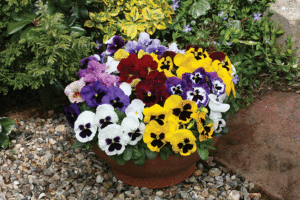
Colors in Floranova’s Magnum line of pansies spans the rainbow. (Photo courtesy Floranova)
Two early bloomers many gardeners turn to for their first bursts of garden color are pansies and primrose.
While both come out early, they each present a different look; the pansey putting out flat or ruffled flowers and the primrose offering a tightly wound rosette.
Even if you have preference of one over the other, they can also provide a unique contrast in the flower bed.
Pansies are widely sold as spring annuals and the color choice spans the rainbow from white, yellow, pink and red, wine and purple, blue and black.
Petals can grow to the traditional two inches or out to five inches.
The pansies grown today are hybrids derived from several species of Viola from Europe and Asia.
Botanically they are known as Viola x wittrockiana and the common name “pansy” comes from the French word “pensée” meaning a thought or reflection. This refers to the flower “face” that is created by bold blotching and veining whiskers on the petals.
Plant pansies as soon as the ground can be worked with a trowel, says Leslie Barlow of Barlow Flower Farm Sea Girt, N.J.
“Pansies and violas like rich, well-drained soil that is high in organic matter (peat moss, compost, ground bark or decomposed manure). They thrive in full sun or partial shade. Shade is especially beneficial when the weather becomes warmer as the hot sun will prevent flower production.”
Barlow adds that pansies need some general upkeep leading up to summer to keep them looking their best.
“Pansies will flower more profusely if older flowers are removed at the base of the stem,” she says. “If the plants are cut back and mulched during the summer, when the cooler weather returns in the fall they will most likely reward you with a new set of blooms.”
Few pansies enjoy hot weather, but they thrive where nights remain above 40 degrees F and day temperatures seldom top 60 to 65 degrees F.
When summer heat kicks in, pansies become leggy and quit blooming. At that point, Barlow advises to either add them to the compost pile or cut the plants back, and pot them to store in a shaded spot protected from the heat.
Pansies may come back into play as fall approaches, too.
“Flowers tend to be smaller, but the plants survive low temperatures through winter, even blooming through snow,” Barlow says. “Mulch to protect from harsh temperatures and wind; avoid wet or very windy places, or next to paths or roadways that are salt-treated in winter.”
In cottage and herb gardens, pansies are traditional, but these colorful plants are ideal for window boxes and containers, too.
“Combine with spring or fall-blooming bulbs, coralbells, sedges, or other attractive perennials,” adds Barlow. “Tuck in among evergreens in rock gardens, or line pathways with them. Remember to protect them from browsing deer that find pansy feasts delectable. Wherever you plant them, you can’t go wrong.”
Growing primrose is easy, as these plants are quite hardy and adaptable according to Nikki Tilley, author of several gardening books including “The Bulb-o-licious Garden.”
The common primrose sold in spring is the polyanthus primrose. They prefer a shaded spot with moist, rich, organic soil. Primroses bloom from the centers of individual rosettes. Where they survive as perennials, these primroses can be divided in later years and replanted.
Tilley says primroses are suitable for use in garden beds and borders as well as in containers or for naturalizing areas of the lawn.
“In fact, when given the proper growing conditions, these vigorous plants will multiply each year, adding stunning colors to the landscape,” she said. “Blooming often lasts throughout summer and in some areas, they will continue to delight the fall season with their outstanding colors. Most primrose flowers range in color from white, cream and yellow to orange, red and pink. There are also purple and blue primrose flowers. These perennial plants prefer damp, woodland-like conditions.”
At garden centers and nurseries, look for primroses that are healthy in appearance, preferably with unopened buds.
Primrose should be planted in lightly shaded areas with well-drained soil, preferably amended with organic matter, Tilley adds. Set primrose plants about 6 to 12 inches apart and 4 to 6 inches deep.
Water thoroughly after planting. Add a layer of mulch around the plants to help retain moisture.
Continue to give your primroses thorough watering throughout the summer months, about once a week or more during periods of drought, but let off once fall approaches.
Keep primrose plants looking their best with regular pruning of dead leaves and spent blooms, she says.
“If you want to collect the seeds of your primroses, wait until late summer or early fall before taking them,” Tilley says. “Store them in a cool, dry place until the following planting season or sow them in a cold frame.”
Slugs and snails are common pests affecting primrose plants but can be controlled with nontoxic slug bait placed around the garden. Tilley says spider mites and aphids may also attack primroses but an application of soapy water can help on that front.
“If primrose plants are not getting enough drainage, they may also be prone to crown rot and root rot,” she says. “This can be easily fixed by amending the soil with compost or relocating the plants to a well-drained site. Too much moisture can also make the primrose flower susceptible to fungal infections.
This can often be prevented by using good watering habits and adequate spacing between plants.”



